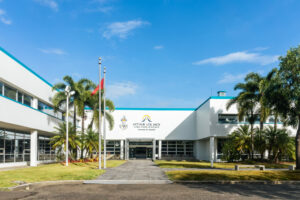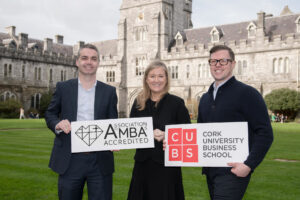AMBA & BGA has launched new research, polling more than 433 leading Business School decision makers globally.
The research, entitled ‘The business of Business Schools’ has been launched to coincide with AMBA’s Business School Leaders Forum (15-26 June 2020), and explores the overall structure of Business Schools and the qualifications they offer.
Key findings
- Business School leaders remain confident that their programmes are updated to reflect the latest trends in business (85% of leaders believe that their School does this well).
- Two thirds of Business School leaders (66%) think the calibre of MBA graduates has increased over the past five years. Meanwhile, half (57%) think the calibre of master’s graduates (excluding MBAs) has increased.
- In terms of finances, tuition and course fees represent the largest proportional source of income for Business Schools, on average, at 68% of all income received.
- On average, MBA programmes account for 25.8% of a Business School’s total income among our respondents.
- Leaders typically believe that factors relating to the reputation of their MBA (cited by 89%) and quality of their MBA (87%) have the greatest impact on demand for their programmes.
- In terms of the most important characteristics Business Schools look for from MBA candidates, prior experience of leadership or business tops the list – 96% of respondents say it is ‘fairly important’, ‘very important’ or ‘essential’.
David Woods-Hale, Director of Marketing and Communications at AMBA & BGA, said: ‘This report throws a spotlight on how Business School leaders view the institutions for which they work, along with offering substantive data on Business School operations and their priorities for 2020 and beyond.
‘Something which comes across strongly in the findings is the high regard leaders have for the core elements of their Business School, such as the quality of its teaching and the calibre of its graduates.
‘Without these strong building blocks of educational institutions, and what they deliver to their core customers – the students – Business Schools would be unable to thrive and produce the kind of research and insight which can help shape the world.’
Demand for Business School programmes
Business School leaders were asked, on a scale of 0-10, to what extent a range of internal and external factors affect demand for the MBA programmes their institution delivers. These results were then analysed by exploring the proportion of leaders who felt that each factor has an influence on demand of at least seven out of 10.
NB: The survey was carried out just before a large number of countries imposed lockdown restrictions in early 2020 due to the Covid-19 pandemic, so this was not included as a factor in the questionnaire.
Leaders typically believe that factors relating to the reputation of their MBA (cited by 89%) and quality of their MBA (87%) have the greatest impact on demand for their programmes. MBA rankings, which are a product of both internal and external factors, are also seen to have a substantial influence on demand. Seven in 10 deem both rankings (71%) and the marketing of their MBAs (67%) as influential factors.
The external factor deemed to have the greatest impact on demand is levels of economic growth in participants’ home countries (59% gave this a significance of at least seven out of 10). In addition, 51% gave a rating of at least seven out of 10 for economic growth within their domestic region and 33% for levels of growth outside their domestic region.
Political issues are seen to have less impact on Business School demand. Three in 10 (30%) gave at least seven out of 10 for domestic political issues and geopolitical issues (27%) as having an impact on demand. This low level of perceived impact may reflect the relative stability of the regions within which responding Business Schools are based.
Leaders were asked to state what proportion of their Business School cohort is international. On average, 46% of cohorts are made up of overseas students, illustrating the importance of international demand on the overall health of Business Schools.
Leaders were asked to what extent various characteristics of an application are important when recruiting MBA students.
Prior experience of leadership or business tops the list – 96% of respondents say it is ‘fairly important’, ‘very important’ or ‘essential’. Oral and written communication is deemed to be the next most important (75% say it’s ‘important’ or ‘essential’), followed by interpersonal skills (72%) and academic achievement (62%). A commitment to social impact was also regarded as being important, with 51% saying it was very ‘important’ or ‘essential’.
The calibre of MBA graduates
Leaders were asked whether the calibre of graduates had increased, decreased or remained the same, as compared to five years ago, across the suite of qualifications available.
Approximately two thirds (66%) think the calibre of MBA graduates has increased, six in 10 (62%) leaders think that the calibre of undergraduate qualification graduates has increased and 52% think doctorate graduates’ calibre has increased. Meanwhile, half (57%) think the calibre of master’s graduates (excluding MBAs) has increased).
Programme delivery
Business School leaders remain confident that their programmes are updated to reflect the latest trends in business (85% of leaders believe that their School does this well). Meanwhile seven in 10 (70%) feel that their School is doing well at ‘delivering MBA programmes which reflect the specific industry needs of the student’.
Three in 10 leaders (30%) say that their Business School offers an industry-specific MBA programme (e.g. oil and gas, luxury management, or finance), and 6% say they have plans to develop industry-specific courses in the future Healthcare was the most frequently mentioned specialist programme.
Leaders were asked whether their Business Schools use external faculty, from outside their own organisations, to help deliver their programmes. More than three quarters of leaders (76%) say that they use external faculty from other institutions to teach elements of modules and more than half (56%) have external faculty delivering complete modules. Meanwhile, almost half (46%) have the support of external faculty to help supervise dissertations.
In terms of faculty, leaders also report that approximately a third (34%) of lecturers are active practitioners in a management discipline while two thirds (66%) are not.
Business School leaders were asked about the suitability of flipped learning as a method of teaching. Flipped learning involves traditional classroom activities being conducted online, while thinking time, which traditionally takes place away from the classroom, is conducted in the classroom.
Almost three quarters of leaders (72%) think flipped learning is a suitable teaching method, with almost a third (32%) saying it is ‘very suitable’. Meanwhile 7% do not think it is suitable. However, the actual use of flipped learning is not particularly prevalent. Slightly more than a quarter (27%) say they use flipped learning at least ‘often’, although a similar proportion say they use if ‘rarely’ or ‘not at all’ (28%).
Leaders were also asked whether they provide blended learning (by which at least 35% of the programme is delivered online). A third (33%) say that they do, six in 10 (60%) say they do not and 8% say they do not know. Those who say that their School conducts blended learning were asked what percentage of these programmes are conducted online.
On average, leaders stated that 38% of the programme content of blended programmes is conducted in this way, signalling the importance of digital learning in these offerings.
Programme innovation
Leaders were asked about the ways in which their Business Schools have innovated in terms of programme delivery in the past year. Positively, some of the measures Schools are taking relate to areas of improvement around flexible learning. One in five say that their School has ‘increased the amount of digital and online learning opportunities’ (22%) and ‘offered flexible timings for delivering programmes’ (19%). Other frequently mentioned innovations include that they ‘collaborated with industry to deliver programmes’ (18%) and ‘increased capacity of teaching related to new technology and innovations (e.g. AI, big data)’ (17%).
Business School finances
Leaders were asked questions about their Business School’s finances.
When looking at funding channels, tuition and course fees represent the largest proportional source of income, on average among responding leaders, at 68% of all income received. This is followed by state funding (18%), corporate sponsorship (4%), foundation donations (2%), alumni contributions (1%), and non-alumni individual donations (1%).
On average, MBA programmes account for 25.8% of a Business School’s total income among our respondents.
Marketing and promotion
Leaders were asked how much money their Business School spent on advertising in US dollars, over the past year, across a range of channels.
Social media: The average across 130 leaders who reported spending on social media was $224,769. If you include all 227 leaders who reported a zero spend, the average spend becomes $107,882. Additionally, if you exclude the three highest and three lowest spends among those who did spend on social media, the average translates to $51,774.
Online advertisements with newspapers, or other publications: Of the 101 leaders who gave a substantive figure on advertising in this area, the average spend was $90,672. When widened to encompass leaders who reported a zero spend in the past year, the average becomes $33,668. Among those who did spend, meanwhile, the average translates to $58,836 when adjusting to take out the three highest and the three lowest figures supplied by our respondents.
Print advertisements: The average spend was $97,203 among those citing a spend on print advertisements. However, this falls to an average of $35,375 if the three highest and three lowest amounts are omitted from the calculation. When including leaders who reported zero spends, the average spend on print advertisements is $32,637.
Paid-for content (e.g. sponsored articles): A total of 60 leaders reported spending an average of $33,962 on paid-for content, or $23,073 if the three highest and three lowest spends are excluded. When including leaders who reported spending nothing at all on paid-for content, the average figure becomes a mere $7,430.
Careers websites: Careers websites attracted an average spend of $25,414, among 55 leaders who said their School spent money in this area over the past year. This figure drops to $17,245 when adjusting to remove the top three and bottom three figures. When including leaders who reported spending nothing at all on careers websites, the average figure is $5,120.
Open days: By far the highest average spend in our survey, at $1,219,400, came from School leaders reporting an advertising spend on open days. However, this figure is heavily skewed by the highest-spend Schools. When adjusting to exclude the top three and bottom three amounts reported, the average falls drastically, to $17,718. If respondents citing a zero spend on open days are included, the average is $373,851, but again this figure is skewed by the highest-spend Schools.
Careers fairs and MBA fairs: Among the 93 leaders who stated that their School spent money on careers fairs, the average was $35,124, decreasing to $30,650 when adjusting to exclude the top three and bottom three figures. When including all School leader respondents, the figure decreases substantially, to $11,922, as a result of many Schools reporting not spending on advertising at all in this area over the past year.
David Woods-Hale, added: ‘As the study highlights, 68% of all Business School income is understood to be derived from student course and tuition fees, on average. It is interesting to note, therefore, that leaders highlight the role of programme quality and reputation in shaping the future demand for its programmes more than they point to the role of external factors, such as local economic growth. Nevertheless, leaders are fully aware that the world they live in does impact on the demand for business students, which is perhaps most obviously highlighted by the high number of students who come from overseas.
‘The study also shows that Business Schools are evolving in how they deliver their programmes, with a substantial proportion of offerings now being delivered either fully or partially online. But leaders are also aware that more needs to be done to implement flexible working methods – and many report that their Schools have recently been innovating in terms of digital learning packages, or operating new ways of teaching methods such as flipped learning. In these areas there remains scope for further growth.
‘On the whole, this report should be a source of optimism for the industry, as Business School leaders report great breadth and depth to their Schools’ differing programmes and topics, funding arrangements, and forms of practice.
‘This variety provides the prospective management education student with a range of options from which to select a high-class degree that suits their ambitions best. In this light, the business of Business Schools looks well prepared to take on the challenges that will arise over the next decade.’
Click here to read the full report.
ENDS
NOTES TO EDITORS
For more information or interviews, please contact:
- David Woods-Hale, Director of Marketing and Communications, AMBA & BGA – d.woods@associationofmbas.com
- Ellen Buchan, Communications and Insight Assistant, AMBA & BGA – e.buchan@associationofmbas.com
Methodology and profile of Business Schools
AMBA & BGA contacted leaders from within its Business School networks to invite them to participate in an online survey between 14 August and 30 September 2019.
The resulting study forms a three-part series of reports that seek to understand how Business Schools are planning for the future. In total, 433 of leading Business School professionals globally participated in this study.
In instances where a survey participant did not complete the survey fully, responses to questions they did complete are included. Where figures do not sum to 100, or to a combined figure, this is due to numerical rounding. The data is unweighted as the country profile of participants broadly matches that of AMBA & BGA Schools.
Participants in the report are referred to as ‘Business School leaders’ or ‘leaders’. Business School leaders that participated in the survey work at institutions that serve a range of cohort sizes.
Approximately two in five (41%) are from Schools with 0-500 students and almost a quarter (23%) are from institutions with 501 to 1,000 students. Smaller proportions of leaders are from Schools enrolled at larger institutions, with 16% working at Schools that enrol between 1,001 and 3,000 students and 19% enrolling more than 3,001 students. The regional composition of participants is broadly comparable with the geographical coverage of AMBA & BGA Schools.
Approximately half of leaders responding to the survey (51%) work at public Business Schools, just under two in five (39%) represent private non-profit Business Schools and 8% are from private for-profit Business Schools. The remaining 2% define their School in another way.
More than two in five Business School leaders (46%) are based in Europe, approximately one in six (16%) are based in the UK and more than one in 10 (12%) are based in Latin America.
The remainder of the sample was from Africa (7%), China (including Hong Kong, China) (6%), Asia and the Middle East (excluding China and India) (5%), India (4%), North America and Caribbean (3%) and Oceania (1%).



